new posts in all blogs
Viewing: Blog Posts Tagged with: figure drawing, Most Recent at Top [Help]
Results 26 - 50 of 67
How to use this Page
You are viewing the most recent posts tagged with the words: figure drawing in the JacketFlap blog reader. What is a tag? Think of a tag as a keyword or category label. Tags can both help you find posts on JacketFlap.com as well as provide an easy way for you to "remember" and classify posts for later recall. Try adding a tag yourself by clicking "Add a tag" below a post's header. Scroll down through the list of Recent Posts in the left column and click on a post title that sounds interesting. You can view all posts from a specific blog by clicking the Blog name in the right column, or you can click a 'More Posts from this Blog' link in any individual post.
The Chinese have a strong tradition of portrait drawing, and the bookshops are full of large folios of drawings.
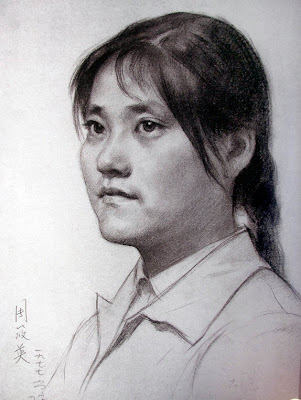
These portrait drawings are not only accurate in the academic sense, but soulful and penetrating psychologically. This one by Jin Shangyi from 1977 is a good example. Jin Shangyi is associated with the Central Academy of Fine Arts in Beijing.
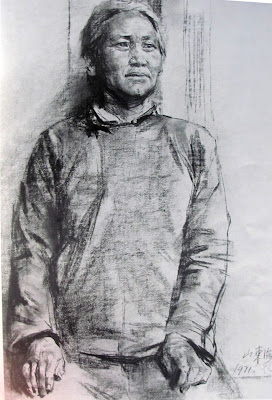
This portrait by Sumiao Jifa Jiaoxue is from 1971. It is direct and sketchy, but precisely observed, with a lot of knowledge behind it.
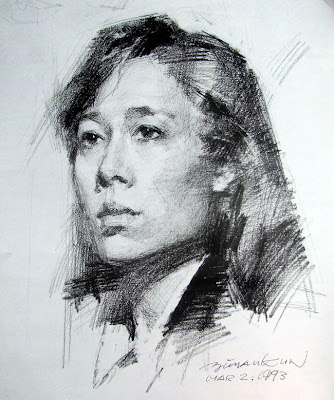
This one, from 1993, shows a method practiced by many of the artists, where the image is constructed from tonal patches, made up of lines drawn quickly with the edge of the pencil. The angular construction gives strength and character, even in a feminine subject.
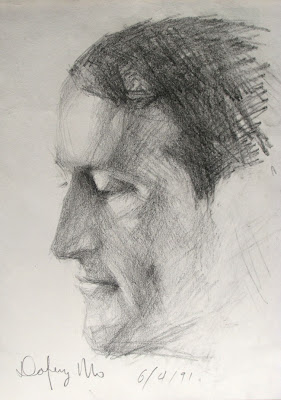
Back in 1991 I met
Dafeng Mo and swapped portraits with him. His portrait of me has the same angular "patch" method. He was the son of a professor at the central academy, and he himself studied there. In his early career he was obliged to paint propaganda posters before making a career as a print and gallery artist in the USA.
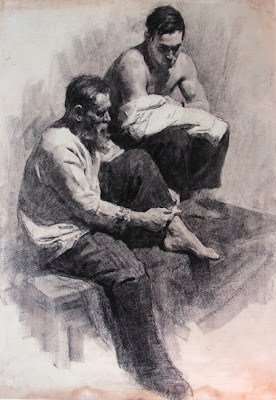
While the West was exploring the various "isms," China under Mao was unswerving in pursuing traditional drawing. The drawing above is from 1960, from a book on the Guangzhuo Academy of Fine Arts, one of several academies still in operation. The training was solid, and these artists were and are extremely competent.
Part of the reason for this competence is that when China was closed to the West, it turned to Russia for its training. Following in the tradition of the great Russian portrait masters Repin, Kramskoy, Fechin, and Serov, the portrait tradition emphasized sincerity, something that is often missing in western portraits.
 16 Comments on Part 8: Shanghai Diary -- Chinese / Russian Drawing, last added: 4/9/2012
16 Comments on Part 8: Shanghai Diary -- Chinese / Russian Drawing, last added: 4/9/2012
When drawing or painting any object, it helps to figure out the big shapes first before defining the details.
That’s especially important in drawing hands. Disney animator Preston Blair wrote one of the classic books on animation drawing. He advised conceiving the hand as a mitten first before drawing the fingers. The little finger can be unevenly placed for variety.
------
Thanks, Michael Stancato
Men's suits get interesting when the pose moves out of neutral. I sketched the same speaker as he shifted back and forth between two poses during his talk.
The jacket and pants hang fairly straight in the left pose. But as he put his hands in his pockets, new points of tension emerge. Folds radiate from the red arrows at the button and the hand. A long pipe fold on his pants leads all the way down past the knee. Because he lifted his shoulders, folds also radiated from his shoulders.
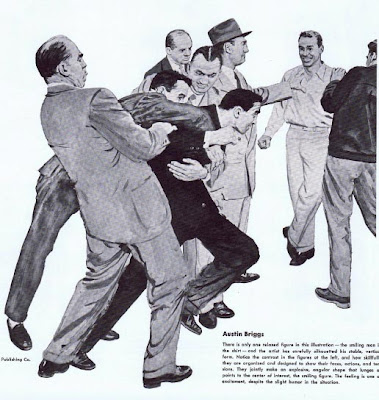
In this illustration by Austin Briggs from the
Famous Artists Course
, the leaning-back figure has folds radiating from the shoulder seam, the knee, and the crotch. But the back is fairly smooth.
There's no substitute for drawing from the costumed model to learn these dynamics, which change not only with the pose, but also with the type of fabric and the construction of the garment.
Had a really fun costumed
model today for life drawing.
Five minute poses.
15 minutes (conte crayon).
20 minutes (conte crayon).
40 minutes (charcoal).
I think I'd rather draw big, froofy dresses than almost anything!
Long pose day... Model was lyrical - my gestures not so much (kept trying though...)
Hmph... anyway...
1-minute gestures..
Left - 20 minutes, right - 40 minutes.
About 40 minutes - conte on smooth newsprint.
Couldn't post yesterday as my computer was all disconnected and in the process of moving from old studio to new studio... Had a fun costumed model to draw this time (although it was a bit hard trying to get all that coat detail in!)
1-2 minute gestures...
5 minute-
20 minutes -
About an hour....
The Vassar College's Frances Lehman Loeb Art Museum in Poughkeepsie, New York is currently presenting "
A Pioneering Collection: Master Drawings from the Crocker Art Museum."The exhibition shows fifty-seven rarely seen drawings dating from the late 15th through the 19th centuries. Artists include Vittore Carpaccio, Albrecht Dürer, Fra Bartolommeo, Federico Barocci, Peter Paul Rubens, Anthony Van Dyck, François Boucher, Rembrandt van Rijn, Jean-Honoré Fragonard and Jean-Auguste-Dominique Ingres.
The collection comes from the Crocker Art Museum in California. A scholarly catalog illustrates and explains the works.
Vassar College's art museum is in Poughkeepsie, New York. The exhibit will be up through December 11.
Exhibition checklist
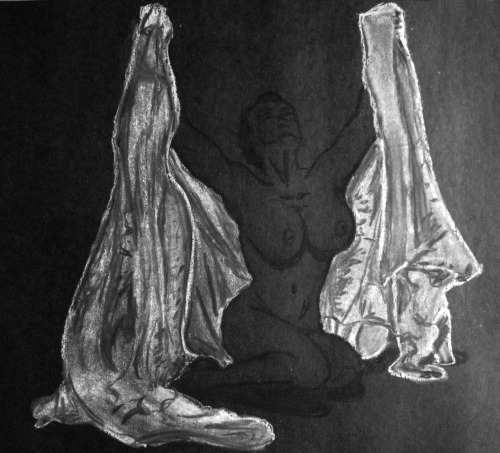
Here’s a figure drawing I gave up on half way through because it was…uh…top heavy. But I kind of like the way the figure being only black on black works with the white sheet so I’ll share it.
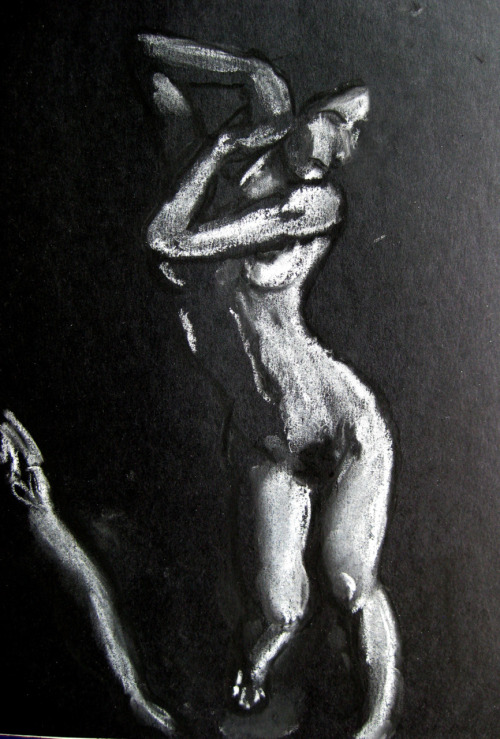
Here is another recent figure drawing I’ve done in my attempt to give myself a better fundamental understanding of drawing the human body. Because it is very hard to find models for such things in China (I hear that nude drawing classes are hard to find outside of the top art schools), I’ve been working from pictures for these. I don’t think it has hurt the experience too much, although I noticed that the couple of times I did live drawing I was able to draw faster and capture the form in a more loose and dynamic way.
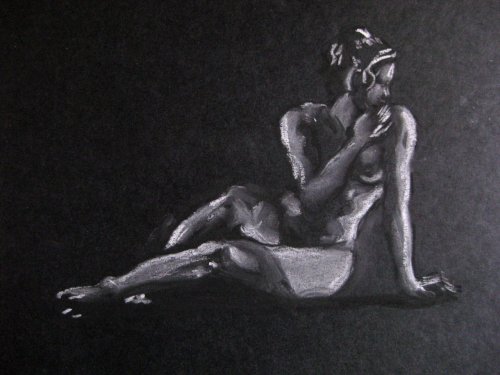
I was stopping myself from posting any of the nude figure drawing I’ve been doing this past year because this blog originally started as a place to talk about our books for children (it has obviously changed focus over time). I’ve come to decide that kind of thinking is totally ridiculous. It’s like saying you should not take kids to a museum because they might see a breast. I have more faith in the parents of the children that read our books, and I’m sorry I ever doubted them.
This is one of the pieces of artwork I’ve done in the past year that I am most proud of. I never attended art school and have had very few chances to do any figure drawing in my life. I now see the attraction of it, and have experienced the incredible learning that happens while participating in it. I look forward to doing more and I will share some here, now that I have come to my senses.
Herbert James Draper (1863-1920) was another one of those lesser-known Victorian painters who combined good drawing with a romantic sensibility in his painting of mythological subjects.

He based the painting “Flying Fish” on a charcoal study from a live model. The figure’s pose, with the foreshortened near arm, is delightful. He keeps his tonal masses simple. The light mass is kept light throughout, allowing much of the upper figure to read very delicately as light-against-light.
Images from the “Inspirational Works of Art” archive (which contains some artistic nudity). Thanks, Keita!
If you like Draper, you’ll like Waterhouse, Leighton, Tadema, Solomon, and Dicksee.
And there's a 2003 book on Herbert Draper.
Costume-model day -
1-2 minute gestures...
5 minute and 10 minute poses...
20 minute poses...
45 minutes...
I looked for the ducklings today, but did not see them. I did see this cute couple (I SO want a banty, blue cochin hen...)
...as well as this gaggle of red-hatted, purple wearing darlings (there are several more just out of frame). Cute flocks all around! :-)
There are several different approaches to an academic art education. Yesterday, Michael John Angel of the Angel Academy of Art presented his teaching methods and philosophy.

A somewhat different approach is offered by Professor Sergey Chubirko, who teaches at the Russian Art Academy, which is also in Florence, Italy.
Rather than try to summarize Professor Chubirko’s method myself (I have not visited his school) or to presume to draw comparisons to other academies, I thought it would be helpful just to look at his drawings and to ask him a few questions about the thinking behind his work.
Gurney: Do you draw what you see or what you know?
Chubirko: I try not to copy unconsciously what I see. The most important point about the model for me is that the model must be inspirational; it must provoke my imagination for the creation of an image.
That is why I never start drawing before I see clearly the image, which I would like to show, through the model. Knowledge of anatomy and the laws of form are certainly necessary as they help me to work independently and to render my thoughts freely and quickly.
Such knowledge must be automatic so that it does not distract, does not bound imagination and, at the same time, introduce independence to the hand. This is the automatic skill that provides an artist with freedom and fluency when he works. An artist should only care about “what” to express not about “how” to do it.

Gurney: How does the knowledge of anatomy shape the way you interpret what you see?
Chubirko: For academic drawing, knowledge of anatomy and the rules of the form need profound studying at the initial stages of art education. Such knowledge should not be ignored as, for instance, knowledge of the alphabet cannot be ignored when one wants to learn to read and write.

When we learn to read and to write we start with A, B, C, after that we put letters into syllables; later we learn how to compose simple sentences, then finally – complex sentences. And, as soon as we have learnt to express ourselves freely in complex sentences, we do not need to go back to the alphabet again. We do not think about letters any longer because they are just tools for a very creative process of reading and writing; for expressing our thoughts and feelings.
Same is in drawing. Knowledge of anatomy and the laws of form is just a tool necessary for an unlimited work of imagination and creation of the artistic images.
 18 Comments on Academic Methods, Part 2: Russian Art Academy, last added: 3/5/2011
18 Comments on Academic Methods, Part 2: Russian Art Academy, last added: 3/5/2011
The teaching methods of the ateliers and academies of the 19th century are undergoing something of a revival around the world. Various teachers have sought to recapture or preserve some of the classic approaches to drawing the figure and composing pictures.

The approach varies from school to school, and the methods are hotly contested among their aficionados. For the next two posts, I thought I would share two different approaches in the words of the teachers themselves.
First is Michael John Angel, whose studio in Florence I visited late last year. In a series of three short videos, he lays out his principles of academic pedagogy:
--------
Here are a bunch of links if you'd like to learn more:
Direct link to YouTube videos:Part 1: , Part 2:, Part 3:
Angel Academy of Art
Michael John Angel
Charles Bargue Painting Course (Book from Amazon)
Pietro Annigoni on Wikipedia
Wikipedia on the Atelier Method & Sight-Size Drawing
Off the Coast of Utopia, fascinating blog by Martinho Isidro Correia
Related GurneyJourney posts:
Angel Academy
Academy of Realist Art, Toronto
Grand Central Academy, New York
Sleepy life drawing today. Certainly make drawing slower and harder...
Couldn't wait to get outside afterwards, and check on the status of the ducklings -
The good news is they are still darling, the sad news is that there are only 6 left (last week there were 8).
Due to the sunshine and the holiday weekend, there were any number of children there - many feeding the birds (and note the seagull in the foreground. Another variety to add to the mix..)
(duckling scoring hunk of biscuit!)
Momma duck continues to herd them along...
...their favorite place continues to be in the water...
1 Comments on Figure Friday - plus, *more* Ducklings!, last added: 2/19/2011
Costume life-drawing day....
5 and 10 minutes...
20 minutes...
...and one hour.
And then *after* life drawing, when strolling out to the car, guess what I saw -
There be ducklings! Eight of 'em even!
Here's a Where's Waldo picture for you - how many types of birds do you see? How many males? females? babies?
And while I don't think any crows made it into the above picture, they were around as well, supervising all that was going on.

Kyle T. Webster’s blog of elegant figure drawing, The Daily Figure, extends its target from curvy women to the denizens of the Star Wars Universe.

It was draped/costume day at life drawing today...
Had a fun time drawing all layery drapery...(15-20 minute poses here).
...while we listened to period soundtracks (Romeo and Juliet, The Virgin Queen, Tristan + Isolde, etc....) Fun day! (1 hour pose).
This drawing by Al Dorne appears in the Famous Artists Course, accompanied by the following caption: “A fine example of the stresses and tensions which show up in clothing when the figure assumes certain positions.”

“Note the way the overalls are bunched into deep half-lock folds in the back of the knee and at the hip joint. On the buttocks, the top of the thigh and the knee, the material stretches tightly over the underlying forms.”
I would add a couple more observations. The folds radiate from points of tension (shoulder, butt, knee, and elbow). Since most modern, fitted garments are constructed to be relatively wrinkle-free for a standing figure, a seated or kneeling figure creates areas of compression where the material has no choice but bunch up.

Folds also radiate from the seams where the arms meet the shoulders on both of these figures. Those folds often don’t continue across the seam because of the contrasts in thickness and fabric grain direction from one side of the seam to another.
All of these effects are softened in knit fabrics (such as T-shirts), which stretch in all directions, as opposed to woven fabrics, which stretch only on the bias.
-------
Famous Artist's School on Wikipedia
Life drawing day -
20-minute segments of a single long pose-
(conte crayon is not the best thing for smallish faces)
-which I got bored of quickly, so I did multiple takes,
but it was crowded, so I couldn't move around much, so I also used multiple media. Some days I find conte the easiest to use with portraits. Today, charcoal pencils were better.
Yet more figure-studies with somewhat more composed vignetted backgrounds...
Trying different approaches...


































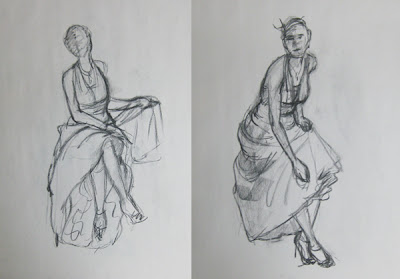



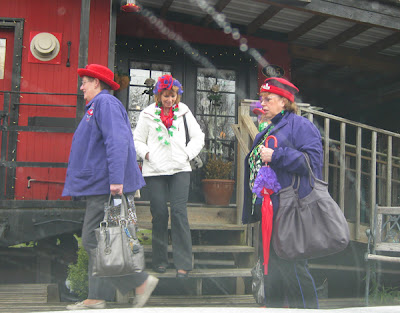






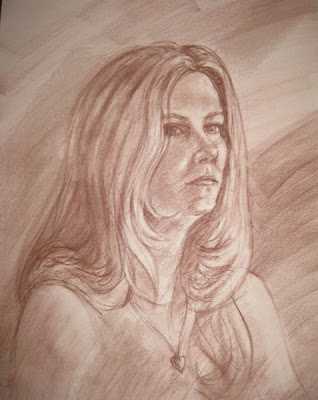













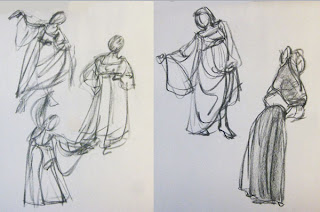









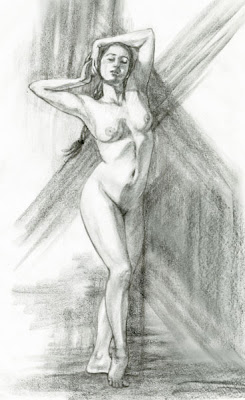

Just catching up on your trip to Shanghai! Great Scott, these are fantastic examples of exquisite drawings. I'm head over heels in love with your sketches in the posts below too. Breathtakingly cool!
This tradition is also alive in America.
I attended the academy of art in San Francisco (where I met you once), and several of the figure drawing teachers are Chinese. They teach the same angular/crosshatching and smudge technique. I know at least one of them went to Russia for training in the '60s.
Yeah, Academy bases it's fundamentals on the Chinese/Russian tradition along with 19th century technique (Sargent) and early 20th century illustration.
James, I wonder how much China owes it's tradition not just to the Russian masters, but to the adoption of Communism. Totalitarian Russian Communism erased the abstract Modernist art of the Constructivists in favor of a saccharine state-ordained romanticism, "social realism". China had a similar propoganda tradition.
This isn't to take anything away from the great social realists like Repin, or to diminish the ability of any of the Chinese artists you've mentioned, but it's also interesting to note that much of the legacy of this tradition in the 20th century is owed to serendipitous totalitarian favor.
I would love to see a piece by piece demo of someone drawing in the russian traditional method. I have always loved russian art and would really like to try my hand at this sot of drawing.
Great post Gurney!
Ah! I haven't heard Mo's name in -years-. We both painted for the Greenwich Workshop around the same time.
Have you stayed in touch?
Perheps Charles would find this interesting?
http://www.nikolai-blokhin.com/videoinfo.php?products_id=400
I would really like to know, if Mr. Gurney could tell me - what do you mean precisely when you say that they are done with a sincerity that is generally lacking in the west? I literally don't know how to tell what you mean, what it is that you're seeing that makes this difference. Could you give examples perhaps? That kind of observation, because it sounds like it's divorced from mere technical excellence, sounds like a very advanced lesson, and I'd appreciate it if you could expand on what you mean - if not in the comments, then perhaps in a second post. You have me curious and I'd really like to know what it is that you're seeing.
@arahmynta I agree. What if said oriental artists lacked sincerity?
Actually I do find that Asian artists (and classical musicians ) are often technically competent but lacking in vitality.
Dan, no I haven't stayed in touch. I'd love to know how Mr. Dafeng and the other Greenwhich China artists are doing.
Anonymous and Arahmynta -- Sincerity is hard to define, but I'll try. By a sincere approach, I mean the opposite of a sarcastic, tongue-in-cheek, superficial, or overly high-concept approach. To me, it has something to do with a living quality, a sympathy, and an expression of an honest feeling. Maybe it has something to do with granting a human subject their own dignity, and showing more than the sum of their features.
Edward, yes, Stalin and Mao had definite ideas about art, and artists had to tow the official line, or else--but some great stuff was done under that system, just as great art was created to advertise Coca-Cola (Go Sundblom!)
Charles, some of the books I picked up have step by steps in the back, so maybe I can post something about that in the future.
I happened to visit the Russian Art Museum in Saint Petersburg without any previous knowledge or awareness of Russian art and I can say I stood awestruck in front of the first portraits I saw (there are literary hundreds of them in the museum). It may be difficult to describe, but there is definitely something different to them than traditional western portraiture. They have a presence, a reality, sincerity, as you call it, that is apparent even to the layman. The people depicted may be dead since hundreds of years and still you have the feeling you instantly know them, like old friends, in a direct and profound sort-of way. Since then, I wonder what is the secret, I mean how do you really practically achieve that "feeling" in a portrait. Glad to know this is a shared experience and was not just an illusion of my mind.
Regarding the Russian art. I've observed what James said and thought the same thing prior to reading this post. It just seems there is training going on in those schools or maybe it's the living conditions in general that allows artists to catch a sincere depiction of human emotion. I find that this quality, for the most part absent in work from certain other countries. Technical ability is one thing. Instilling character into a drawing is quite another. Wanna see lots of art, go to Stumble Upon and start stumbling!
I'm intrigued. Where should I start to find out more about this Russian tradition? Any book or website recommendations?
This is powerful stuff; I agree that there can be a certain lack of sincerity in some Western art(as much as the majority of my influence and inspiration has come from the West).
Looks like you may have found the topic for your next book James! :)
These are wonderful drawings - thank you for showing them to us and highlighting what makes them different.
Interesting read. I'd love to know if there is a popular name for this angular "patch" drawing method, so I could find out more about it.
Groo, I don't know the name for the "patch" method, but the idea of bounding a form with straight lines and using mosaic-like patches of tone was common in French training, particularly with Carolus Duran.
Anonymous, the Repin academy in Russia is still very active, and you can learn more about it online. There's also a school in Florence taught by Professor S. Chubirko, who I interviewed on a previous blog post: http://gurneyjourney.blogspot.com/2011/03/academic-methods-part-2-russian-art.html